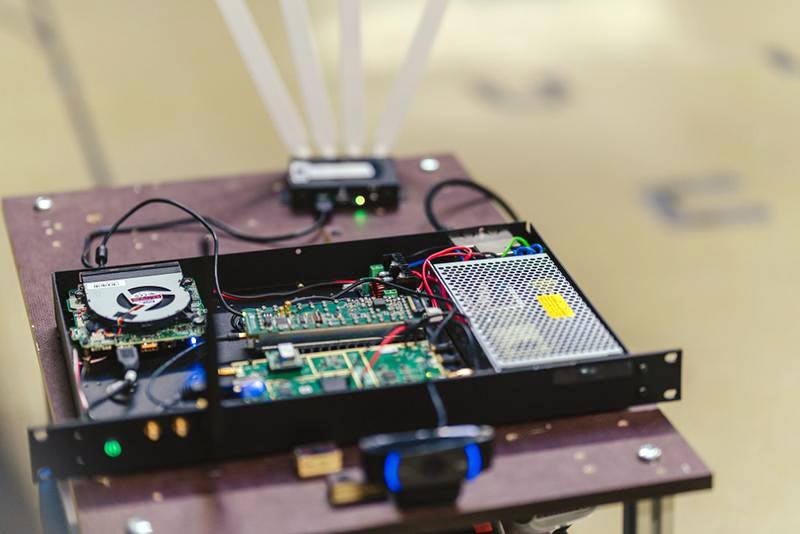
AI4Mobile: Enhancing Mobile Communication with AI Solutions

AI4Mobile project boosts performance for industry and transport
© AI4Mobile
AI4Mobile boosts performance for industry and transport.
The research project AI4Mobile (AI-supported mobile communication systems for mobility in industry and transport) has successfully come to an end. Led by the Fraunhofer Heinrich-Hertz-Institut (HHI), researchers of the AI4Mobile consortium have worked on the development of AI-based communication solutions for various mobility applications within this project since 2020.
The project was funded by the German Federal Ministry of Education and Research (BMBF) with 5.1 million euros as part of the German federal government’s high-tech strategy in the field of “Artificial Intelligence in Communication Networks”. In order to modernize mobile communications systems and networks for future use, AI4Mobile focused on the development of innovative artificial intelligence and machine learning methods.

© AI4Mobile
The AI4Mobile research team designed methods that enable the prediction of quality of service (QoS) for high mobility as well as proactive resource optimization and networking in all parts of the mobile network infrastructure. The QoS prediction solutions will detect critical states in mobile networks well in advance, including undefined system conditions or extreme interference and even the complete loss of network coverage.
“The findings presented by AI4Mobile have reinforced the notion that machine learning will be an important element in the evolution of mobile networks,” said Jan-Peter Meyer-Kahlen, head of Ericsson’s Eurolab research and development site.
Within the framework of AI4Mobile, researchers identified various use cases from the fields of transportation and industry, such as teleoperated driving and cooperation between mobile and stationary robots, and analyzed them with regard to their respective requirements.
To generate data and evaluate the concepts, the team took a three-stage approach consisting of the virtual replication of the systems, private campus networks in laboratory and factory environments, and extensive test and measurement campaigns in public scenarios or mobile networks. The datasets generated in the project include information from all parts of the cellular infrastructure (terminals, radio access network, core network), vehicle-specific information (e.g., route, position, speed), data from high-quality sensors (e.g., LIDAR), and publicly available contextual information such as traffic and weather data. The consortium has published a large part of the data sets obtained during the measurement campaigns as well as the software for the complete data processing chain.
“By publishing the datasets, the AI4Mobile consortium is making an important contribution to the research and development of AI-based algorithms for mobile applications by research groups worldwide,” comments Prof. Slawomir Stanczak, head of the “Wireless Communications and Networks” department at Fraunhofer HHI.
The Berlin V2X dataset provides high-resolution GPS-located wireless measurements in various urban environments in Berlin for both cellular and sidelink radio technologies. The data was collected using four vehicles over three days.
The AI4Mobile iV2V and iV2I+ Industrial Wireless datasets contain wireless measurements from two industrial test environments: iV2V (industrial vehicle-to-vehicle) and iV2I+ (industrial vehicle-to-infrastructure plus sensor). The data includes information on physical layer parameters (e.g., signal strength and signal quality), position data as well as wireless QoS such as delay and throughput. The datasets are annotated and pre-filtered for fast onboarding and applicability.
The developed solutions will support novel mobility applications in passenger transport, freight transport and industrial production environments. Furthermore, the predicted QoS information is used to develop AI mechanisms for real-time optimization and dynamic adaptation in all parts of the mobile networks.
“Thanks to the work with our partners in this project, we have achieved important results for the use of AI-based communication solutions. One example is the prediction of connection quality for Connected Mobility and Industry 4.0,” reports Dr. Frank Hofmann, Chief Expert for Communication Systems at Bosch Research.
Besides Fraunhofer HHI, the following partners were involved in the project: BMW AG, Robert Bosch GmbH, Enway GmbH, Ericsson GmbH, Götting KG, RFmondial GmbH, TU Dresden (Vodafone Chair for Mobile Radio Systems and Deutsche Telekom Chair for Communication Networks), RPTU Kaiserslautern (Chair for Radio Communication and Navigation).
The over 30 publications produced in the context of AI4Mobile are listed under the link below.
Wissenschaftliche Ansprechpartner:
Martina Müller
Press Officer
Phone +49 30 31002 242
Email martina.mueller@hhi.fraunhofer.de
Dr.-Ing. Martin Kasparick
Technical Contact
Phone +49 30 31002-853
Email martin.kasparick@hhi.fraunhofer.de
Originalpublikation:
https://newsletter.fraunhofer.de/-viewonline2/17386/753/3/6RFhct0v/NpBwyivxbz/1
Weitere Informationen:
https://ieee-dataport.org/open-access/ai4mobile-industrial-wireless-datasets-iv2…
https://ieee-dataport.org/open-access/berlin-v2x
https://www.ai4mobile.org/#publikationen












